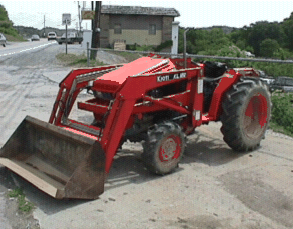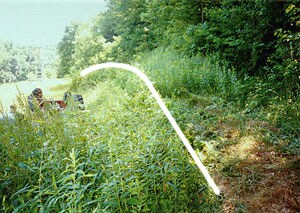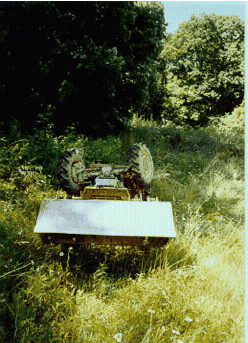Rental Property General Laborer Dies Following a Tractor Roll Over in West Virginia.
Investigation # 99WV035-01
Release Date: February 21, 2000
SUMMARY
On June 22, 1999, a 49-year-old male rental property general laborer (victim) died of injuries sustained when the tractor he was driving rolled over while mowing. The victim was using a 26 horsepower, three cylinder diesel, four wheel drive tractor which was owned and usually operated by the property’s owner. The tractor was equipped with a front end loader and a rear mounted brush hog. The operator (victim) was inexperienced in tractor operation and set-up. He was instructed by the owner to perform other assigned tasks and wait for his presence and instruction before moving the tractor out of the storage shed, setting it up, and mowing. Usual set-up included installing the tractor’s rollover protective structures (ROPS) which had to be taken off in order to store the piece of equipment. The field had been graded two years prior to the incident and had never been mowed. The grading had left a fairly level area adjacent to the access road. upon. Above this level area was a 12 foot wide ridge which ran along the woods line and created a 3 foot ledge leading down to the level area. Just prior to the fatal incident, the victim decided to access, set-up and operate the tractor without the owner being present and before receiving instruction. He began mowing the field at the highest point which was along the woods line upon the ridge. According to the owner, this ridge was not included in his mowing plans, as it was to be cut with a string trimmer. The victim was operating the tractor with its left side parallel to and within 2 feet of the ledge. He had completed 30 feet of mowing when the left front wheel and then the left rear wheel dropped off the edge causing the tractor to rollover pinning him to the ground. The tractor did not have a ROPS due to incomplete set-up. Approximately one hour later, the tractor’s owner drove up to the mowing site and spotted the upside down piece of equipment. The victim was lying face up with the upside down tractor across his chest. The owner got back into his car and drove to a nearby towing business and called 911. Two of the towing business employees checked for vital signs. The EMS arrived within minutes. The tractor was removed from the victim and he was pronounced dead. The coroner estimated that the victim had died shortly after tractor impact.
The WV FACE investigator concluded that to reduce the likelihood of similar occurrences, the following guidelines should be followed by tractor owners:
- Ensure that unauthorized tractor operation is prevented by having exclusive control of the ignition key.
Additionally, employees should:
- Follow the employer’s instructions concerning the scheduling and implementation of assigned tasks and pre-task training.
- Ensure that all tractors equipped with removable or folding (ROPS) and a seat belt only be operated with the system fully installed.
INTRODUCTION
On June 23, 1999, the WV FACE Program was notified by a newspaper clipping of a work-related tractor fatality that occurred on June 22, 1999. The WV FACE field investigator met with the county sheriff to review the fatality. The sheriff then accompanied the field investigator to the incident site. Measurements and photographs were taken and the police report and police photographs were reviewed. The death certificate and medical examiner’s report were obtained. The victim’s employer was interviewed as well as the property’s tenants and neighboring towing service employees regarding the incident.
The employer in this incident was a retired nursery owner who has rented the property since his retirement. The rental property owner had no full time employees.
The victim had worked for the property/tractor’s owner in the past while the nursery was in operation. Since that time the victim would do “odd jobs” and was paid for each job. He had never operated the tractor and was described by the owner and other rental property tenants as “inexperienced” when it came to tractor operation and mowing.
The job which was going to be assigned to the victim was to mow the lower flat of the field.
The task was to take place after receiving detailed instructions and oversight by the tractor’s owner. Instruction and oversight was to include set-up and operation. The tractor’s owner, who was also the usual operator, had recently had an operation and therefore was unable to perform the task himself.
INVESTIGATION
On June 22, 1999, a 49-year-old male rental property general laborer (victim) died of injuries sustained when the tractor he was driving rolled over while mowing. The victim was using a 26 horsepower, three cylinder diesel, four wheel drive Kioti tractor, model LK 2554 which was owned and usually operated by the property’s owner (see Figure 1). The tractor was equipped with a front end loader and a rear mounted brush hog. The operator (victim) was inexperienced in tractor operation and set-up. He was instructed by the owner to perform other assigned tasks and wait for his instruction before moving the tractor out of the storage shed, setting it up, and mowing. Usual set-up included installing the tractor’s ROPS, which had to be taken off in order to store the piece of equipment. It was reported by the property’s tenants and neighboring towing service employees that usual operation of the tractor included the ROPS being installed. The field had been graded 2 years prior and had never been mowed. The grading had left a fairly level area adjacent to the access road. Above the level area was a 12 foot wide ridge which ran along the woods line and created a 3 foot ledge leading down to the level area. Just prior to the fatal incident, the victim decided to access, set-up and operate the tractor without instruction. He began mowing the field at the highest point which was along the woods line upon the ridge. According to the owner, this ridge was not included in his mowing plans as it was to be cut later with a string trimmer (see Figure 2). The victim was operating the tractor with its left side parallel to and within 2 feet of the ledge. He had completed 30 feet of mowing when the left front wheel and then the left rear dropped off the edge, causing the tractor to roll over and pinning him to the ground (see Figure 3). The tractor did not have a (ROPS) due to incomplete set-up. Approximately one hour later, the tractor’s owner drove up to the mowing sight and spotted the upside down piece of equipment. The owner saw the victim who was lying face up with the upside down tractor across his chest. The owner got back into his car and drove to a nearby towing business and called 911. Two of the towing business employees checked for vital signs. The EMS arrived within minutes. The tractor was removed from the victim and he was pronounced dead.
CAUSE OF DEATH
The cause of death listed on the death certificate was traumatic asphyxiation.
RECOMMENDATIONS/DISCUSSION
Recommendation #1: Tractor owners should ensure that unauthorized tractor operation is prevented by having exclusive control of the ignition key.
Discussion: In this incident, the victim had been told by the employer to wait until he was given the necessary information and instruction to do the job safely. The employer was planning on assisting the victim in removing the tractor from storage as well as the proper set-up for the task at hand. The employer was also going to give the victim instruction concerning the tractor’s safe operation as well as what part of the field was to be mowed and what part would require a string trimmer due to its unsafe configuration. It is unclear as to why the victim decided to access, set-up and operate the tractor without waiting for instruction. Although the employer communicated his requirements to the victim, the tractor was accessible as was the ignition key. Had the owner had exclusive control of the ignition key the victim would have been unable to operate the piece of equipment. Having ensured that unauthorized operation wasn’t possible may have prevented the incident.
Recommendation #2: Employees should follow the employer’s instructions concerning the scheduling and implementation of assigned tasks and pre-task training.
Discussion: This incident involved a total disregard for the employer’s instructions. Workers need to understand that owner and supervisory work orders may be safety related. The day before the incident it was reported that a discussion took place between the employer and the victim. Witnesses reported that the discussion’s content included specific orders by the employer concerning the scheduling and implementation of the assigned task and the necessary pre-task training. Specifically discussed was the issue of waiting for his presence and instruction concerning the mowing of the field. Had the victim followed the previously discussed work orders, the incident may have been prevented.
Recommendation #3: Employees should ensure that all tractors equipped with removable or folding (ROPS) and a seat belt only be operated with the system fully installed.
Discussion: Preventing death and serious injury to tractor operators during rollovers requires the use of ROPS and a seat belt. These structures, either a roll-bar frame or an enclosed roll-protective cab, are designed to withstand the dynamic forces acting on them during a rollover. In addition, seat belt use is necessary to ensure that the operator remains within the “zone of protection” provided by the ROPS. Usual set-up for the tractor involved in this incident included installing the ROPS, which had to be taken off in order to store the tractor. It was reported by the property’s tenants and neighboring towing service employees that usual operation of the tractor included the ROPS being present. If the tractor involved in this incident had been fitted with its ROPS and the seat belt had been in use, this fatality might have been prevented.
ILLUSTRATIONS

Figure l. This photograph shows the tractor involved in the fatal incident.

Figure 2. This photo shows the level area on the left which was to be mowed.
The white line indicates the location of the ledge.
The ridge along the tree line on the right was to be string trimmed.
The photo also shows the actual mowed path and the inverted tractor.

Figure 3. This photo shows the tractor’s final inverted resting place.
FATALITY ASSESSMENT AND CONTROL EVALUATION PROGRAM
The WVU Center for Rural Emergency Medicine, through a contract with the West Virginia Department of Health and Human Resources, conducts investigations on the causes of work-related fatalities within the state. The goal of this program is to prevent future fatal work-place injuries. West Virginia FACE intends to achieve this goal by identifying and studying the risk factors that contribute to work-place fatalities, by recommending intervention strategies, and by disseminating prevention information to employers, employees, trade associations, unions, equipment manufacturers, students, teachers, and others with an interest in work-place safety.
Please use information listed on the Contact Sheet on the NIOSH FACE website to contact In-house FACE program personnel regarding In-house FACE reports and to gain assistance when State-FACE program personnel cannot be reached.
